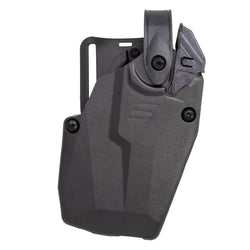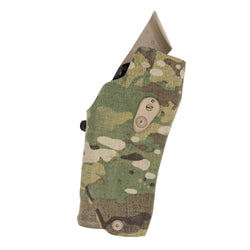The “See the World” slogan has been a recurring theme in United States Navy recruitment efforts for decades, while the Marines’ Hymn highlights the United States Marine Corps’ foreign deployments in wartime. Yet, when the phrase “boots on the ground” comes to mind today, it reminds us that the United States Army has sent its military personnel to distant lands to protect American interests and fight the foes of freedom and democracy.
For much of its 250-year existence, the United States Army didn’t actually fight wars abroad, but it has deployed soldiers beyond the nation’s borders since its origins.

Today, approximately 166,000 active-duty military personnel are stationed overseas at nearly 750 bases around the world. The bulk of those forces are from the United States Army, which currently has deployed soldiers to every continent, even Antarctica, where they mostly fight the cold while supporting the U.S. Antarctic Program.
Origins of the U.S. Army as a Global Fighting Force
This year famously marks the founding of the Army on June 14, 1775, which occurred more than a year before the signing of the Declaration of Independence.
That same month, the newly formed “Continental Army,” the precursor to the modern service, also launched its first “foreign action,” the invasion of Quebec. The objective was to seize the Province of Quebec, now part of modern-day Canada, and convince the French-speaking Canadiens to join the revolution. Though it ended in a British Victory, the campaign highlighted the Continental Army’s early ambition to expand the war effort beyond the Thirteen Colonies.
The Marines’ Hymn may highlight the Corps’ role in the Mexican-American War (April 1846 – February 1848) with its opening line “From the Halls of Montezuma,” yet, the bulk of the American fighting force in that conflict was primarily made up of U.S. Army soldiers. To mount the attack on Mexico, the Army was greatly expanded from just over 7,200 soldiers to 35,000, while an additional 73,000 volunteers further filled the ranks alongside Sailors and Marines. It marked the largest deployment of U.S. military personnel on foreign soil for half a century.

It was far from the largest expansion of the U.S. military.
Just 13 years later, the country was almost torn apart by the American Civil War. The U.S. Army swelled in size to save the Union, reaching more than one million men by the end of the conflict. Yet, by 1874, there were just 25,000 men in its ranks. Those professional soldiers served not in a distant land but still one that was alien to them, namely the untamed West.
The Frontier Army helped facilitate the country’s westward expansion, building infrastructure, providing security, and maintaining order until civil governments could be established. It likely helped prepare the U.S. Army for future overseas deployments.

Ready to Fight in Distant Lands
In 1898, when the United States found itself at war with Spain, it emerged onto the world stage, but was far from a global power in any sense of the world. At the start of the Spanish-American War, the U.S. Army had even fewer than 25,000 soldiers in its ranks. President William McKinley then issued calls for volunteers, hoping the Army would see its ranks doubled. Instead, more than 200,000 volunteered, while state National Guard units were also mobilized.
The U.S. Army may have fought in Canada and Mexico and helped tame the frontier, but it was set to join the U.S. Marine Corps and U.S. Navy in fighting a foreign war. Those branches had seen overseas action in the Barbary Wars (1801-1805) and the Sumatra Expedition of 1832, but it was finally the Army’s turn.
Its campaign in Cuba marked the first deployment of the U.S. Army in a foreign land by ship when the Fifth Army Corps landed on the Spanish-controlled island, the largest colony in the Americas. Though it occurred two weeks after the First Marine Battalion put boots on the ground, the landings still marked the first action by U.S. Army soldiers overseas.
The Fifth Army Corps took part in the Battle of San Juan Hill, where the famed 1st United States Volunteer Cavalry, the “Rough Riders,” were led into combat under Colonel Theodore Roosevelt. That was followed by the Battle of El Caney and the Siege of Santiago.

In the Pacific, the United States Navy’s Asiatic Squadron under the command of Admiral George Dewey destroyed the Spanish fleet at the Battle of Manila Bay on May 1, 1898. However, despite the stunning U.S. victory, it didn’t mark the end of the fighting in the Philippines. Three months after the decisive naval victory, American forces led by United States Army General Wesley Merritt landed near Manila. The battle for the capital city of the then-Spanish colony has become known as the “Mock Battle of Manila,” as it transferred control of Manila, while also keeping the Philippine Revolutionary Army on the outskirts of the city.
That action set the stage for the opening stage of the largely forgotten Philippine-American War, the first major insurgency the United States military faced.
The U.S. Army in the Philippines
After defeating Spain in the first of “Uncle Sam’s Little Wars,” the United States suddenly became a colonial power. It gained the islands of Puerto Rico in the Caribbean and Guam in the Pacific. It also took control of the Philippines, much to the chagrin of the aforementioned Philippine Revolutionary Army, which had hoped to gain independence from Spain just as Cuba had.

Washington had other plans and refused to recognize the Philippine Declaration of Independence, resulting in the Philippine-American War (February 1899 – July 1902). The U.S. government sought to justify its actions by suggesting it was protecting the Philippines from “European predators,” namely Germany, which had its own designs on the former Spanish colony.
The U.S. Army didn’t have any say, as it was not to question why, but rather to do and die.
The conflict evolved into a guerrilla war, a portent of the overseas conflicts the U.S. military would later face in Vietnam, Afghanistan, and Iraq. The war with the Filipino revolutionaries overlapped with the Moro Rebellion (May 1902 to June 1913), which began in earnest as the U.S. moved to impose its authority over the Muslim states of Mindanao, Jolo, and the neighboring Sulu Archipelago.
The Moro peoples had already had a long history of resisting foreign rule, and much of those regions’ territory was never fully brought under Spanish control. The U.S. Army faced a force like no other. The fanatical warriors wore armor made of either brass or caribou leather plates, and despite their Muslim faith, often took opium or other narcotics to intoxicate themselves before engaging in combat. That indirectly resulted in the U.S. Army’s decision to develop a new sidearm, as the Colt .38 caliber handgun proved ineffective in stopping the Moro during their suicidal attacks. It led to the adoption of the Colt M1911 .45 pistol!
The Wars of the 20th Century – The U.S. Army Went “Over There”
Though the United States Marine Corps was part of the international force that defended the Legation Quarter in Peking (modern Beijing), China, during the Boxer Rebellion in 1900, the U.S. Army participated in the China Relief Expedition as part of the Eight-National Alliance. That marked the first time that U.S. Army soldiers fought alongside those of Europe in a distant land, while it was also the first time U.S. soldiers were deployed to Asia.

Just over a decade into the 20th century, the United States Army mounted another campaign in Mexico in March 1916. Originally known as the Punitive Expedition U.S. Army, it is now officially known as the Mexican Expedition, but it has also been called the Pancho Villa Expedition. It was launched in retaliation for Mexican revolutionary Villa’s attack on the border town of Columbus, New Mexico.
Though not a significant conflict, the expedition marked the first motorized military action in U.S. history, led by then-Lt. George S. Patton. Commanding around 15 men, Patton succeeded in confronting Julio Cárdenas, a leader in the Villista military, during which time the revolutionary and two others were shot dead. To make a point, Patton had all three dead Mexicans strapped to the hood of the cars and driven back to General John J. Pershing’s headquarters. The same expedition saw the first use of U.S. reconnaissance aircraft in a military operation.
The brief action in Mexico may also have helped prepare the U.S. Army for the war already raging in Europe.

On April 6, 1917, the United States declared war on Germany and joined the UK, France, Imperial Russia, Italy, and the other “Allied” powers in entering what was later to be known as the First World War. The United States Army grew considerably, reaching a standing force that consisted of 127,500 officers and soldiers. The American Expeditionary Force (AEF) grew to a total strength of just under four million men by November 1918, with roughly half sent to Europe.
Although the first American troops arrived in Europe in June 1917, the AEF didn’t fully participate in front-line actions until October. American divisions were employed throughout 1917 and into early 1918 to augment French and British units. Following the U.S. victory at Cantigny, the AEF commanders increasingly assumed sole control of U.S. military forces in combat. The U.S. Army participated in several major engagements, including the Battle of Cambrai, the Somme Defensive, the Battle of Aisne, the Champagne-Marne Offensive, and notably the Meuse-Argonne Offensive. By the time the guns fell silent on November 11, 1918, the AEF had evolved into a modern, combat-hardened unit recognized as one of the best in the world.
Beyond serving on the Western Front, the U.S. Army supported the Allied intervention during the Russian Civil War by sending approximately 13,000 soldiers to Siberia and North Russia. Around 5,000 soldiers served in the AEF, North Russia, as part of the Polar Bear Expedition, which lasted until July 1919.

America’s role in the First World War (and accompanying campaigns) provided valuable strategic lessons to an officer corps that would form the nucleus for commanding the more than 16 million U.S. military personnel that took up arms in the Second World War.

The U.S. Army went on to play a significant role in every theater of operation during World War II, including the European Theater, the Pacific Theater, and the North African/Mediterranean Theater. The Army was then part of the occupation force in both Germany and Japan, and in the past 80 years has been involved in literally dozens of actions around the world during the Cold War and then the Global War on Terror (GWoT).










